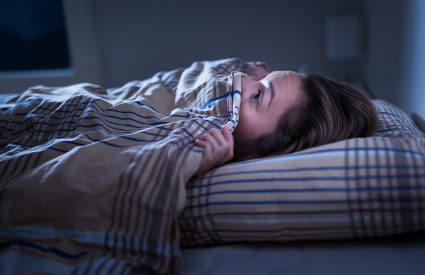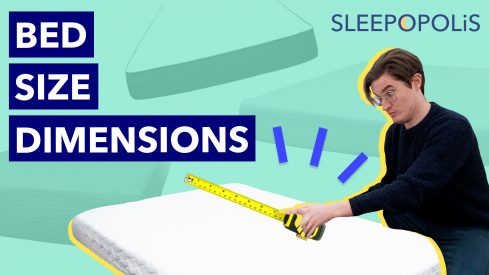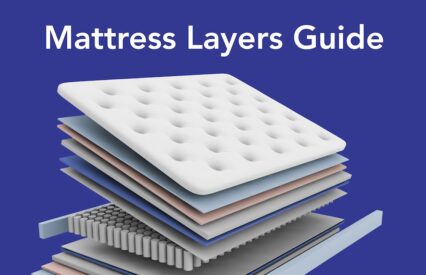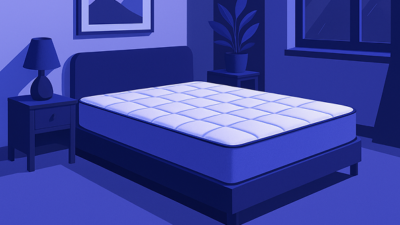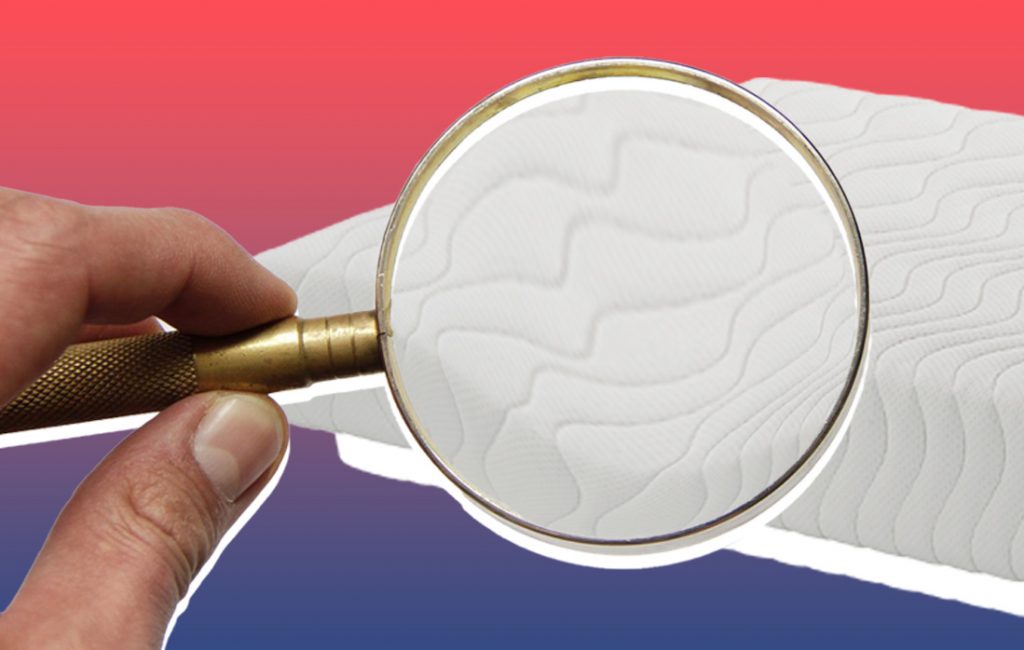
It’s been a long and exhausting day. You just can’t wait to get home, get into your bed, and cozy up on top of that cushy, comfy… fiberglass!?
It may sound like something out of a Saw movie, but mattress manufacturers often pack tiny glass fibers into their mattresses to make them more flame retardant. That’s good for safety standards, but does it pose a risk to your health? Are you cursed to live in fear that fiberglass particles are going to escape from your mattress and contaminate your home?
Pump the brakes, sleep fam. We’re the mattress experts here at Sleepopolis, so we put together today’s guide to thoroughly cover the topic of fiberglass in mattresses, why it’s used, the risks of fiberglass exposure, and our list of fiberglass-free mattress alternatives.
Don’t curb that mattress in a panic before you get the facts. Check out everything you need to know about fiberglass in mattresses below.
Why Do Some Mattresses Contain Fiberglass?
Fiberglass is commonly used for building and home insulation, so it’s not something that you’d expect to find inside your mattress. So, why would a mattress company put tiny shards of glass inside the thing that you’re supposed to sleep on each night?
The simple answer: Mattresses are highly flammable, especially mattresses using polyurethane like the increasingly popular memory foam mattresses. Fiberglass is a fire retardant that, in the event of a fire, acts as a fire barrier. The fiberglass slows the spread of the flames, giving you a chance to escape before the highly combustible mattress materials underneath ignite.
The use of fiberglass in mattresses dates back to 2007. The National Institute of Standards and Technology (NIST) found that bed fires caused one in six fire deaths in the United States in the early 2000s. To reduce this grim statistic, they worked with several organizations, including the Consumer Product Safety Commission (CPSC), to develop a fire safety test and establish federal flammability standards for all mattresses sold in the United States.
Mattress companies initially tried to meet federal standards by treating their materials with flame retardant chemicals, namely polybrominated diphenyl ethers (PBDEs). However, studies began to uncover potential health risks1 associated with PBDEs, and in response to these findings and increasingly high flammability standards, mattress brands began choosing to use a physical barrier instead.
And so, thanks to it being heat-resistant and relatively cheap, mattress companies began using fiberglass to offer chemical-free fire protection and meet federal safety standards.
Risks and Concerns with Fiberglass in Mattresses
Fiberglass is not inherently dangerous and should pose no risk to your health and safety as long as it stays inside your mattress. However, if the outer cover of your mattress is damaged and you own a mattress that contains fiberglass, there are definitely some risks and concerns to be aware of.
Skin Irritation
According to the International Journal of Dermatology2, being exposed to fiberglass may cause contact dermatitis, a skin condition characterized by inflammation, redness, itching, or dryness, and you may develop a painful rash. That’s because fiberglass is made from tiny glass shards or fibers that can scratch, pierce, and penetrate the skin if you just so happen to be tossing and turning on them all night long.
Again, the fiberglass poses no health issue if it’s safely stored inside the mattress, but damage to the outer cover may reveal the fiberglass and lead to problems.
Respiratory Issues
Those fine glass fibers don’t just wreak havoc on the outside, they may also cause or contribute to respiratory problems if you happen to inhale them.
According to a 2020 study in the International Journal of Environmental Research and Public Health3, the inhalation of airborne fiberglass particles may cause adverse health effects, namely a higher occurrence of chest infections like bronchitis.
A 2022 study4 by the same publication also found that breathing in fiberglass could exacerbate asthma by irritating the nose, mouth, and throat, but thankfully the particles are often too large to penetrate deep into the chest and lungs.
Home Contamination
The mattress label clearly warned against removing its cover, but you weren’t sure how else to wash the darn thing so you popped it open figuring what’s the worst that could really happen to you.
Big mistake.
This family in Utah did the same thing and wound up with an absolute nightmare of a situation as shards of fiberglass became embedded in their clothing, carpets, and upholstery. Worse yet, fiberglass particles can get into your HVAC system and wind up compromising the air quality of your entire home, requiring professional cleaning to completely remove everything.
It may sound farfetched, but it’s a very real possibility. That’s why it’s prudent to peruse all labels and manufacturer’s instructions regarding mattress care, replace mattresses if the outer layer is damaged, and consider using a mattress protector so that there’s virtually no way for fiberglass to wreak havoc in your home.
How to Know If Your Mattress Contains Fiberglass
So, have you been sleeping on a fiberglass-filled disaster waiting to happen, or can you sleep peacefully knowing your mattress is fiberglass-free?
Manufacturers are legally required to share what’s inside their mattresses, but some mattress companies aren’t so forthcoming with this information and may try to obfuscate the ugly truth.
For example, their labels may read “glass fiber” or “glass wool” when, in actuality, these are just different ways of saying “fiberglass.” A mattress cover label may warn you to never remove it while conveniently neglecting to mention why you should leave it be.
Thoroughly read all labels, care instructions, and even information from the manufacturer’s website to determine if your mattress contains fiberglass. If you really can’t say for sure, you may consider calling the company directly and, if they can’t provide firm confirmation that your mattress is fiberglass-free, then go with your gut and proceed accordingly.
Remember, fiberglass isn’t inherently dangerous, but considering the risks, it’s important to know if your mattress contains fiberglass or not.
Safer Alternatives to Fiberglass in Mattresses
You may be thinking right now that your best bet is to avoid mattress brands that use fiberglass altogether. Thankfully, there are plenty of high-end, eco-friendly, and organic mattress options on the market that will give you peace of mind and a good night’s sleep. In fact, our experts picked out 10 of the best mattresses without fiberglass, so that’s a great place to start.
Other than our favorites, there are plenty of great options if you’re looking for a new mattress that doesn’t contain fiberglass. Here are a few alternatives:
- Wool: Wool chars instead of igniting, so it’s naturally flame resistant. It also provides some temperature regulation, so you stay snug in the winter and cool in the summer.
- Cotton (treated or layered): Cotton makes a solid flame barrier when quilted thickly or treated with safe, non-toxic methods. No fiberglass required.
- Latex: Some mattress companies combine natural latex with wool to create a material that’s fire resistant, comfortable, and, most importantly, fiberglass-free.
- Rayon or silica-based barriers: Premium brands often use rayon infused with silica (essentially sand) to create a fabric that resists flames without the risks of loose fibers.
Generally speaking, the budget brands love using fiberglass, whether they’re direct about using it or attempt to hide it using fancy terminology, so we recommend shopping premium brands to avoid the headaches altogether. Whatever you choose, make sure you read the label thoroughly before finalizing the sale, so you’re not accidentally stuck with a mattress containing fiberglass.
Conclusion
We know a lot of the information about fiberglass in mattresses above sounds scary, but you don’t necessarily have to grab your mattress and chuck it out the window for peace of mind.
Instead, we recommend the following:
- Read all labels and care instructions thoroughly
- Never remove a mattress covered labelled as “Do Not Remove”
- Consider safer alternatives when you next buy a mattress
Fiberglass can’t hurt you if it stays where it’s supposed to be, so many people don’t mind the risk since it lets them get a good quality mattress at an affordable price.
The best mattress for you, however, will always be the one that lets you sleep with total peace of mind. If you don’t have that with your current mattress, there are fiberglass-free alternatives available that may help you feel safe and sound while you sleep once again.
FAQs
Is fiberglass in mattresses dangerous?
No, fiberglass in mattresses is not dangerous. It’s when the fiberglass gets out of the mattress that the trouble can begin, which may entail skin irritation, respiratory problems, contamination of your home, and other issues that require serious effort or professional assistance to resolve.
How can I tell if my mattress has fiberglass?
Mattress manufacturers must by law disclose if there is fiberglass in the mattress, but that won’t stop them from being sneaky about it. Check the label for terms like “fiberglass,” “glass fiber,” or “glass wool,” as all of these indicate that the mattress has fiberglass inside.
What should I do if fiberglass leaks from my mattress?
If you suspect that fiberglass has leaked from your mattress, don’t panic, but do act quickly:
- Put on protective gear: Gloves, goggles, and a mask or respirator.
- Limit airflow: Close all windows, switch off fans, and shut down your HVAC.
- Carefully seal the mattress: You can grab a mattress bag, which is usually used for moving or disposing of a mattress, from a nearby retailer or Amazon. Carefully get the mattress inside and seal it shut to prevent fibers from spreading.
- Remove belongings: Bag bedding, clothing, and personal items to remove them.
- Wipe down hard surfaces: All walls, floors, and pieces of furniture.
- Vacuum: All carpets, upholstery, and other surfaces using a vacuum with a HEPA filter.
- Dispose of bags: Anything that can’t be cleaned (and the vacuum bag when you’re finished vacuuming) should be discarded immediately.
We won’t sugarcoat it: Cleaning up after your home is potentially contaminated by fiberglass is a lot of work, so you may consider calling a professional to take it off your hands.
Which mattress brands don’t use fiberglass?
Many premium, organic, and luxury mattress brands feature “fiberglass-free” designs. Brands like Saatva, Helix, and DreamCloud are some of our favorites.
Whatever brand you choose, be sure to double-check the product description or manufacturer’s site before buying to confirm that it contains no fiberglass. Better safe than sorry.
Sources
1. Xue J, Xiao Q, Zhang M, Li D, Wang X. Toxic Effects and Mechanisms of Polybrominated Diphenyl Ethers. Int J Mol Sci. 2023;24(17):13487. Published 2023 Aug 30. doi:10.3390/ijms241713487
2. Camacho I, Rajabi-Estarabadi A, Eber AE, et al. Fiberglass dermatitis: clinical presentations, prevention, and treatment – a review of literatures. Int J Dermatol. 2019;58(10):1107-1111. doi:10.1111/ijd.14407
3. Moitra S, Farshchi Tabrizi A, Idrissi Machichi K, et al. Non-Malignant Respiratory Illnesses in Association with Occupational Exposure to Asbestos and Other Insulating Materials: Findings from the Alberta Insulator Cohort. Int J Environ Res Public Health. 2020;17(19):7085. Published 2020 Sep 28. doi:10.3390/ijerph17197085
4. Wagner J, Fowles J, Barreau T. Fiberglass and Other Flame-Resistant Fibers in Mattress Covers. Int J Environ Res Public Health. 2022;19(3):1695. Published 2022 Feb 1. doi:10.3390/ijerph19031695


